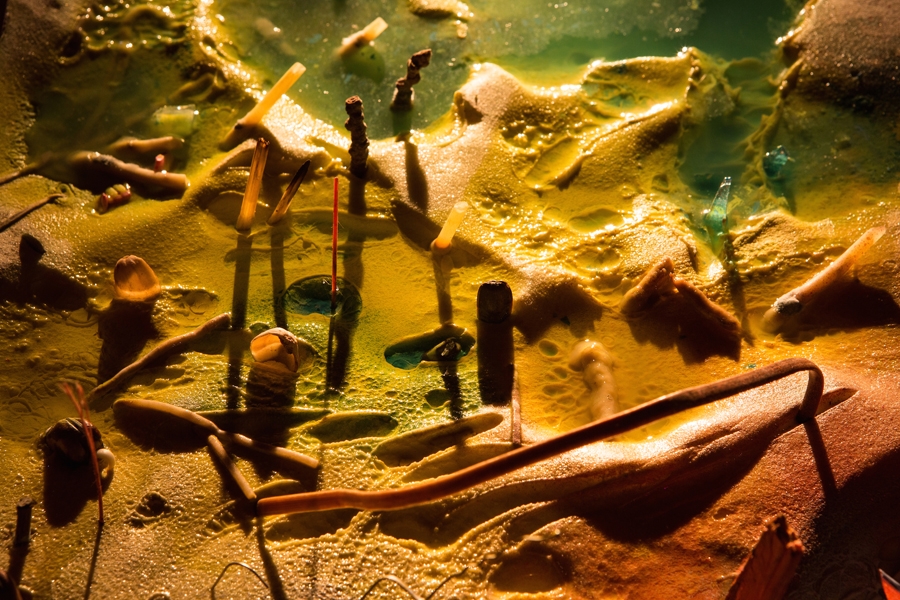Stepping into the entrance corridor of the Sunday Painter, I can’t help but notice a pungent minty smell – as if the gallery space itself had been forced to gargle in mouthwash. In fact it emanates from a large amount of toothpaste applied directly to the entrance wall to make up the mural Landscape (2014). Deposited using an impasto technique that is reminiscent of Van Gogh’s landscape compositions, the lines of toothpaste are imprinted by ink transfer with undefined bits of magazine images, which together form a swirling, colourful view of a mountainous horizon. Needless to say, Samara Scott’s first solo exhibition at this Peckham space is a sensuous experience, exploring both the glamorous and the obscure materiality of everyday consumer culture through a series of unconventional landscapes.
In the main gallery space the landscape is immersive. Dim spotlights fill the room with peach and fuchsia hues reminiscent of a tropical sunset, while a dozen small sculptural compositions – punctuating the gallery floor like shiny islands in an archipelago – are highlighted by brighter lights. Presented on trays and other rectangular supports, these little islands, each showcasing unworldly landscapes in shades of pastel, emerge from the layering and fusion of food, makeup and other chemical materials, textures and smells. Hills and valleys surface from agglomerations of wet, dyed and winesoaked toilet paper; raw spaghetti and incense sticks are planted on moist insulation-foam cottages like bare trees; elsewhere, crevasses carved in insulation foam are filled with water and food colouring, while beads of a broken necklace float in a puddle of water and nail polish.
There is something disturbingly lubricious to all the liquids and fluids running through the sculptures (hair gel and fabric softener do the job particularly well) and coalescing the different textures, which Scott emphasises in her exhibition text, evoking images ‘promiscuously mating other images’, and ‘surfaces clambering in and out of one another’. The exhibition title, Harvest, also conjures up a celebration of nature, a season often associated with ideas of fertility and abundance, but also with excess; here it becomes a metaphor for the chronic cycles of consumption and waste constitutive of consumerist culture, where desire and greed inevitably lead the way to excessive consumption, and in turn a certain nausea.
Surprisingly enough, though, Scott seems detached from any kind of statements on the social or environmental issues that stem from these capitalist patterns. Infused with a genuine Pop-like fascination with the overexposure to images and products one experiences daily, Scott attempts to capture the superficiality and artifices that lure the individual into consumption. She extracts the poetic, glamorous and mnemonic qualities from these objects and substances and, through a customised composting process, recycles them into sentimental topographies. In a digitally saturated era, Scott appeals to our senses and instincts with a multisensory experience, and it feels almost as refreshing as the Aquafresh whiff in the corridor.
This article was first published in the March 2015 issue.
